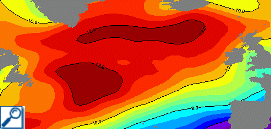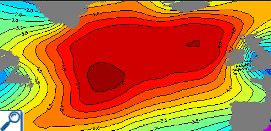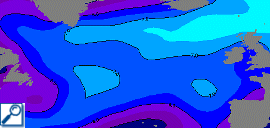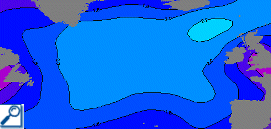Variable winds in North Atlantic
Lively Data - February 15, 2008
By being the place of deep water formation flowing southwards, the northern part of the North Atlantic is an important area in ocean circulation at a large scale (thermohaline circulation). At the surface, the Gulf Stream balances this movement by allowing a redistribution of heat from the equator to the poles. So it is a high variability area that we have already seen in this section, in terms of sea level anomalies (September 22, 2006 : Atlantic Ocean with steric effects, February 18, 2004 : North Atlantic sea level heights over time).
This area should be also the place of radical changes with the global warming. And paradoxically, it should be rather cool (Applications : Long-term climate prediction). The Gulf Stream flows could be changed, letting Europe to the mercy of winds and winter storms (Applications : Atlantic storm wave heights at hurricane's level).
Seasonal averages of Wind Speed Modulus (left) and Significant Wave Height (right) during winter 2007 (top) and summer 2007 (bottom). Select NRT > Global > Gridded Wind Speed Modulus merged. Choose "define variable" in the left menu. This option allows you to compute some statistics with data sets. Choose "average", click on "T" and define your temporal period and finally your area.
Further information :
- Another pages on our website with the North Atlantic Ocean
- See Ovide's cruises results.
![]() Use the LAS
Use the LAS










